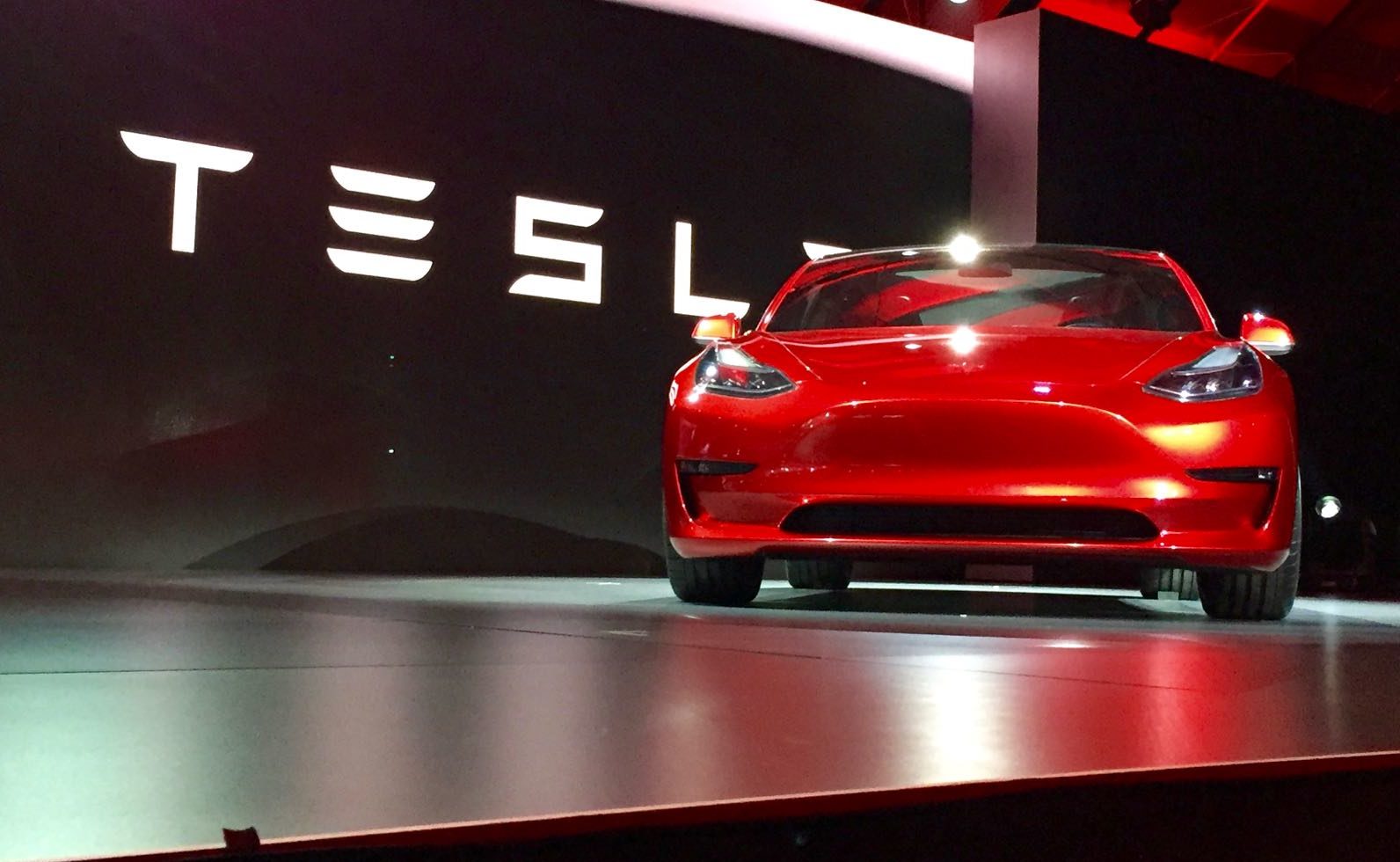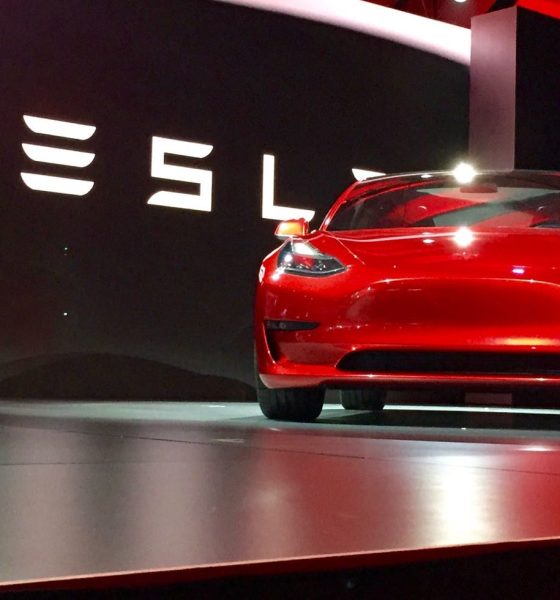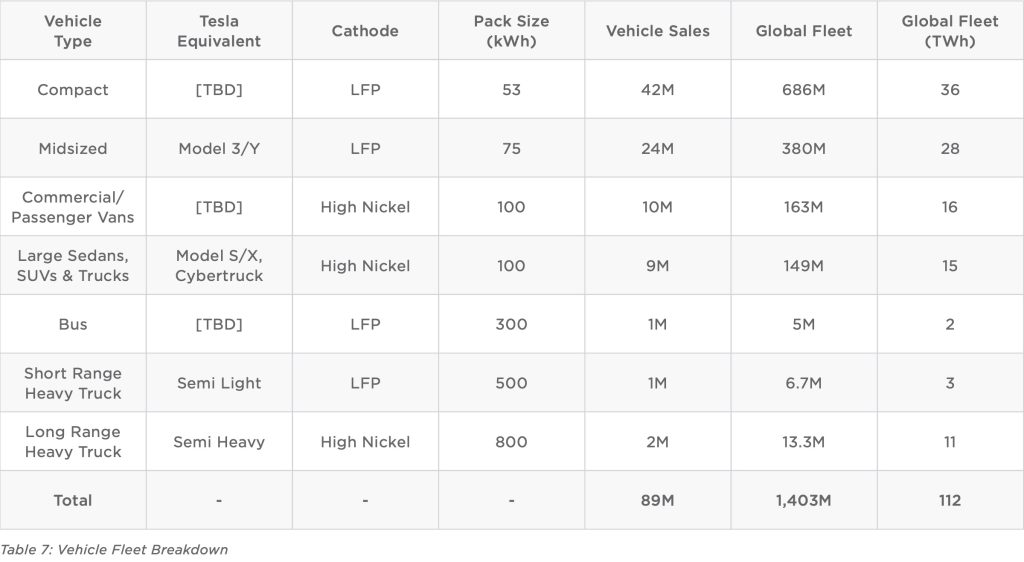

News
Tesla teases 3 next-gen vehicles in Master Plan Part 3, all in different segments
On its recently-shared Master Plan Part 3, Tesla teased three new vehicles with its next-generation platform, including a compact car, a commercial/passenger van, and a bus.
Tesla’s Master Plan Part 3 focused on seven vehicle fleet categories, including compact and midsized cars; large cars, SUVs, and pickup trucks; commercial vehicles, buses; and heavy-duty trucks. Tesla has released vehicles in four out of seven of those categories and plans to release three new cars under the compact vehicle segment, in the commercial/passenger van market, and a battery electric bus.

Tesla “Model 2“
Tesla Giga Mexico is expected to produce the company’s next-generation vehicle. However, the Texas-based EV maker has yet to announce which next-generation car it will produce in Mexico.
Although, there is strong evidence to conclude that Tesla will launch the long-awaited $25,000 car, fondly called the “Model 2” or “Tesla Q” among EV enthusiasts. A few details are known about Tesla’s compact vehicle. In Master Plan Part 3, Tesla revealed that the Model 2 will have a 53 kWh battery pack using lithium iron phosphate (LFP) cells. Based on the table below, Tesla expects the compact car to sell more than its popular midsized Model 3 and Model Y vehicles, nearly double the units.
There is little competition in the compact battery electric vehicle market, making it ripe for the taking in the global market. Volkswagen already struck the first blow in the competition by announcing its compact ID.2 car, designed to be the successor to the VW Golf.
Tesla Commercial and Passenger Vans
Elon Musk has also talked about a potential Tesla van in the past. Like the compact BEV market, a few automakers seek to make a name for themselves in the segment, including Rivian, Volkswagen, and Mercedes-Benz.
According to Tesla’s Master Plan Part 3, its commercial and passenger vans will use 100 kWh battery packs with high nickel cells. Tesla aims to sell 10 million commercial and passenger vans.
Tesla Bus
The idea of a Tesla makes sense now that the company has started manufacturing and delivering its heavy-duty battery electric truck: the Semi. The Tesla Semi’s availability on the market hints that Tesla has solved certain constraints—including battery constraint issues—that prevented it from delivering heavy-duty vehicles.
In its Master Plan Part 3, Tesla notes that its electric bus will use 300 kWh battery packs using LFP cells.
Tesla’s Master Plan Part 3 teases a new direction for the company with its next-generation platform. Tesla’s new adventure will likely feature some challenging obstacles and more meme-worthy moments from Elon Musk. And more fun for Tesla investors and supporters.
The Teslarati team would appreciate hearing from you. If you have any tips, contact me at maria@teslarati.com or via Twitter @Writer_01001101.

News
Tesla FSD fleet is nearing 7 billion total miles, including 2.5 billion city miles
As can be seen on Tesla’s official FSD webpage, vehicles equipped with the system have now navigated over 6.99 billion miles.

Tesla’s Full Self-Driving (Supervised) fleet is closing in on almost 7 billion total miles driven, as per data posted by the company on its official FSD webpage.
These figures hint at the massive scale of data fueling Tesla’s rapid FSD improvements, which have been quite notable as of late.
FSD mileage milestones
As can be seen on Tesla’s official FSD webpage, vehicles equipped with the system have now navigated over 6.99 billion miles. Tesla owner and avid FSD tester Whole Mars Catalog also shared a screenshot indicating that from the nearly 7 billion miles traveled by the FSD fleet, more than 2.5 billion miles were driven inside cities.
City miles are particularly valuable for complex urban scenarios like unprotected turns, pedestrian interactions, and traffic lights. This is also the difference-maker for FSD, as only complex solutions, such as Waymo’s self-driving taxis, operate similarly on inner-city streets. And even then, incidents such as the San Francisco blackouts have proven challenging for sensor-rich vehicles like Waymos.
Tesla’s data edge
Tesla has a number of advantages in the autonomous vehicle sector, one of which is the size of its fleet and the number of vehicles training FSD on real-world roads. Tesla’s nearly 7 billion FSD miles then allow the company to roll out updates that make its vehicles behave like they are being driven by experienced drivers, even if they are operating on their own.
So notable are Tesla’s improvements to FSD that NVIDIA Director of Robotics Jim Fan, after experiencing FSD v14, noted that the system is the first AI that passes what he described as a “Physical Turing Test.”
“Despite knowing exactly how robot learning works, I still find it magical watching the steering wheel turn by itself. First it feels surreal, next it becomes routine. Then, like the smartphone, taking it away actively hurts. This is how humanity gets rewired and glued to god-like technologies,” Fan wrote in a post on X.
News
Tesla starts showing how FSD will change lives in Europe
Local officials tested the system on narrow country roads and were impressed by FSD’s smooth, human-like driving, with some calling the service a game-changer for everyday life in areas that are far from urban centers.

Tesla has launched Europe’s first public shuttle service using Full Self-Driving (Supervised) in the rural Eifelkreis Bitburg-Prüm region of Germany, demonstrating how the technology can restore independence and mobility for people who struggle with limited transport options.
Local officials tested the system on narrow country roads and were impressed by FSD’s smooth, human-like driving, with some calling the service a game-changer for everyday life in areas that are far from urban centers.
Officials see real impact on rural residents
Arzfeld Mayor Johannes Kuhl and District Administrator Andreas Kruppert personally tested the Tesla shuttle service. This allowed them to see just how well FSD navigated winding lanes and rural roads confidently. Kruppert said, “Autonomous driving sounds like science fiction to many, but we simply see here that it works totally well in rural regions too.” Kuhl, for his part, also noted that FSD “feels like a very experienced driver.”
The pilot complements the area’s “Citizen Bus” program, which provides on-demand rides for elderly residents who can no longer drive themselves. Tesla Europe shared a video of a demonstration of the service, highlighting how FSD gives people their freedom back, even in places where public transport is not as prevalent.
What the Ministry for Economic Affairs and Transport says
Rhineland-Palatinate’s Minister Daniela Schmitt supported the project, praising the collaboration that made this “first of its kind in Europe” possible. As per the ministry, the rural rollout for the service shows FSD’s potential beyond major cities, and it delivers tangible benefits like grocery runs, doctor visits, and social connections for isolated residents.
“Reliable and flexible mobility is especially vital in rural areas. With the launch of a shuttle service using self-driving vehicles (FSD supervised) by Tesla in the Eifelkreis Bitburg-Prüm, an innovative pilot project is now getting underway that complements local community bus services. It is the first project of its kind in Europe.
“The result is a real gain for rural mobility: greater accessibility, more flexibility and tangible benefits for everyday life. A strong signal for innovation, cooperation and future-oriented mobility beyond urban centers,” the ministry wrote in a LinkedIn post.
News
Tesla China quietly posts Robotaxi-related job listing
Tesla China is currently seeking a Low Voltage Electrical Engineer to work on circuit board design for the company’s autonomous vehicles.

Tesla has posted a new job listing in Shanghai explicitly tied to its Robotaxi program, fueling speculation that the company is preparing to launch its dedicated autonomous ride-hailing service in China.
As noted in the listing, Tesla China is currently seeking a Low Voltage Electrical Engineer to work on circuit board design for the company’s autonomous vehicles.
Robotaxi-specific role
The listing, which was shared on social media platform X by industry watcher @tslaming, suggested that Tesla China is looking to fill the role urgently. The job listing itself specifically mentions that the person hired for the role will be working on the Low Voltage Hardware team, which would design the circuit boards that would serve as the nervous system of the Robotaxi.
Key tasks for the role, as indicated in the job listing, include collaboration with PCB layout, firmware, mechanical, program management, and validation teams, among other responsibilities. The role is based in Shanghai.
China Robotaxi launch
China represents a massive potential market for robotaxis, with its dense urban centers and supportive policies in select cities. Tesla has limited permission to roll out FSD in the country, though despite this, its vehicles have been hailed as among the best in the market when it comes to autonomous features. So far, at least, it appears that China supports Tesla’s FSD and Robotaxi rollout.
This was hinted at in November, when Tesla brought the Cybercab to the 8th China International Import Expo (CIIE) in Shanghai, marking the first time that the autonomous two-seater was brought to the Asia-Pacific region. The vehicle, despite not having a release date in China, received a significant amount of interest among the event’s attendees.








